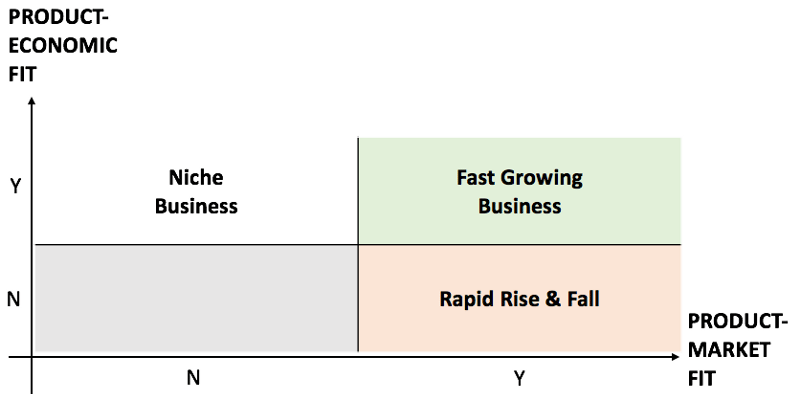
When a management with a reputation for brilliance tackles a business with a reputation for bad economics, it is the reputation of the business that remains intact. — Warren Buffet
Rapid Rise and Fall
Groupon was hailed by Fortune in 2010 as the fastest company ever to reach $1 Billion in revenue. Groupon had the kind of Product-Market Fit that every founder dreams about. Amazing appeal with both consumers and businesses with “35,000 companies clamoring to be on its roster. Only one in eight applicants makes the cut.” But the same article identifies the problem “Anyone can replicate it. More than 200 copycat sites have sprung up in the U.S., with another 500 overseas, including 100 in China.” Just 3 years later the founder and CEO had resigned.

Product-Market Fit
A product needs to do two things well: create value & capture value. When there is abundant capital, these two phases can have years between them.
Focusing all your energy on product-market fit and getting customers to love your product is often good advice. There is no point in monetizing something until it is proven with customers. Also, it allows building products where the business model may not be obvious (e.g. Google Search and AdWords).
Conventional wisdom is that if a team is “baseline competent and the product is fundamentally acceptable”, you will get to success after product-market fit. If that is the case, why do so many startups that achieve product-market fit struggle and fail? And why do all startups in some product categories fail?
Product-Economic Fit
There is another equally important component: Product-Economic Fit. This is determined by the overall economics of the product category and the position of the company in that product category. Product-Economic Fit is the ability for a product to achieve attractive economics at scale.
It is assumed that after Product-Market fit, you will eventually find Product-Economic fit. However, this incorrectly captures the relationship. Product-market fit does not guarantee product-economic fit. In fact they are completely orthogonal.

Each product-category has its own category economics. And no great product can escape the gravitational pull of poor category economics in the long-term.
Once a company has proven that they can achieve product-market fit, competitors are quick to emerge. With the competitive onslaught, whether or not you have product-economic fit quickly becomes apparent. This competitive onslaught has been evident in categories like coupons (Groupon, Living Social), flash sales (Gilt, Fab), ride sharing (Uber, Lyft), food delivery (Eat24, Caviar, GrubHub) and others.

A Familiar Pattern
Here is how the story plays out over and over again for companies that can’t achieve Product-Economic Fit:
- Someone discovers an interesting opportunity which seems to resonate with many customers. If the company executes well, they hone the product and eventually start accelerating. Product-Market Fit!
- The metrics tell a great story with strong customer desire and growth rates. They claim that one of their advantages is the head-start that they have in the market. The company is hailed as a breakthrough. This is a great time to raise funding.
- The company may even start monetizing customers. They can achieve healthy margins as they are the first to product-market fit. The company is expected to have a very bright future. This is also the best time to sell.
- Others notice the traction and momentum of the company. If the product category has low barriers to entry, lots of companies follow the same path. Sometimes they are direct replicas and sometimes there is some slight differentiation.
- Competitors are now present and marketing and pitching against the company. It’s hard for customers to really tell the difference between the offerings. Maybe they sign-up for multiple. If there are low switching costs, price wars start and drive profit margins down.
- The company’s growth slows and profitability collapses and investors and press are surprised how this promising company lost its way. To fix things there might be a change of CEO, strategy and name. But the problem is not execution, it is Product-Economic Fit.
It can take multiple years to play through these phases. What makes this particularly insidious is that the company is getting all the right signals along the way. Customer traction, customer desire, willingness to pay. Check, check, check.
Conclusion
Initially focusing on Product-Market fit is often good advice. However, product teams should know that there is a second hurdle awaiting them in the form of Product-Economic fit. This is determined by the overall economics of the product category and the position of the company in the product category.
There is an additional problem with waiting to think through the economics of your product category. Once you have locked on your Product-Market fit approach you have few degrees of freedom. For companies that have raised substantial funding based on a certain product approach there is little tolerance for course corrections.
Product teams should focus on product-market fit, but great product teams think through what would happen if they succeed.
Originally published here.


























